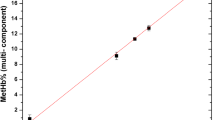Abstract
Instrumental epithermal neutron activation analysis was used in determining the halide concentration of camel serum. The halides determined were sodium, chloride, bromide, and iodide. Serum was examined when the camels had free access to drinking water, following 10 d of water restriction and 2 h following rapid rehydration. When the camels were dehydrated there was a “serum storage” of iodide. This confirms the decline in thyroid metabolism previously described (15). Following rehydration the thyroid metabolism returned to normal. Dehydration also increased the serum bromide concentrations. This could have a tranquilizing effect, abetting the decrease in metabolism. There were no changes in sodium or chloride metabolism. It is concluded that use of neutron activation will allow an analysis of halides for physiological research.
Similar content being viewed by others
References
Z. Etzion, N. Meyerstein, and R. Yagil,J. Appl. Physiol. Resp. Environ. Exerc. Physiol. 56, 217 (1984).
G. E. Folk, Jr.,Introduction to Environmental Physiology. Lea and Febiger, Philadelphia, PA, 1966, pp. 308.
W. F. Ganong,Medical Physiology, 12th ed., Lange Medical, Los Altos, CA, 1981.
E. M. Gryntakis and J. I. Kim,J. Radioanal. Chem. 76, 341 (1983).
V. W. Hays and M. J. Swenson, inDukes' Physiology of Domestic Animals, 9th Ed. M. J. Swenson, ed., Cornell University, Ithaca, NY, 1977, pp. 395–412.
D. L. Ingram and L. E. Mount,Man and Animals in Hot Environments, Springer-Verlag, New York, NY, 1975.
N. Lavi and Z. B. Alfassi,Analyst 109, 361 (1984).
C. M. Lederer and V. S. Shirley,Table of Isotopes, 7th Ed., John Wiley and Sons, New York, NY, 1978.
W. V. Macfarlane, inHandbook of Physiology, Section 4,Adaptation to the Environment, D. B. Dill, ed., Am. Physiol. Soc., Washington, DC, 1964.
S. K. Sharpless, inThe Pharmacological Basis of Therapeutics, 4th Ed., L. S. Goodman and A. Gilman, eds., Macmillan, London, 1970, pp. 121–134.
B. D. Siebert and W. V. Macfarlane,Physiol. Zool. 48, 36 (1975).
R. Yagil, U. A. Sod-Moriah, N. Meyerstein,Am. J. Physiol. 226, 298 (1974).
R. Yagil, U. A. Sod-Moriah, and N. Meyerstein,Am. J. Physiol. 226, 301 (1974).
R. Yagil and G. M. Berlyne,Renal Physiol. 1, 104 (1978).
R. Yagil, Z. Etzion, and J. Ganani,J. Appl. Physiol. 45, 540 (1978).
R. Yagil and Z. Etzion,Comp. Biochem. Physiol. 63A, 275 (1979).
R. Yagil and Z. Etzion,J. Dairy Res. 47, 159 (1980).
R. Yagil,The Desert Camel—Comparative Physiological Adaptation, Karger A. G. Basel, Switzerland (1985).
Author information
Authors and Affiliations
Rights and permissions
About this article
Cite this article
Etzion, Z., Alfassi, Z., Lavi, N. et al. Halide concentrations in camel plasma in various states of hydration. Biol Trace Elem Res 12, 411–418 (1987). https://doi.org/10.1007/BF02796697
Issue Date:
DOI: https://doi.org/10.1007/BF02796697




